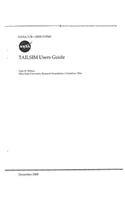
Tailsim Users Guide
Series:
The TAILSIM program uses a 4th order Runge-Kutta method to integrate the standard aircraft equations-of-motion (EOM). The EOM determine three translational and three rotational accelerations about the aircraft's body axis reference system. The forces and moments that drive the EOM are determined from aerodynamic coefficients, dynamic derivatives, and control inputs. Values for these terms are dete
NaN
VOLUME
English
Paperback

The TAILSIM program uses a 4th order Runge-Kutta method to integrate the standard aircraft equations-of-motion (EOM). The EOM determine three translational and three rotational accelerations about the aircraft's body axis reference system. The forces and moments that drive the EOM are determined from aerodynamic coefficients, dynamic derivatives, and control inputs. Values for these terms are determined from linear interpolation of tables that are a function of parameters such as angle-of-attack and surface deflections. Buildup equations combine these terms and dimensionalize them to generate the driving total forces and moments. Features that make TAILSIM applicable to studies of tailplane stall include modeling of the reversible control System, modeling of the pilot performing a load factor and/or airspeed command task, and modeling of vertical gusts. The reversible control system dynamics can be described as two hinged masses connected by a spring. resulting in a fifth order system. The pilot model is a standard form of lead-lag with a time delay applied to an integrated pitch rate and/or airspeed error feedback. The time delay is implemented by a Pade approximation, while the commanded pitch rate is determined by a commanded load factor. Vertical gust inputs include a single 1-cosine gust and a continuous NASA Dryden gust model. These dynamic models. coupled with the use of a nonlinear database, allow the tailplane stall characteristics, elevator response, and resulting aircraft response, to be modeled. A useful output capability of the TAILSIM program is the ability to display multiple post-run plot pages to allow a quick assessment of the time history response. There are 16 plot pages currently available to the user. Each plot page displays 9 parameters. Each parameter can also be displayed individually. on a one plot-per-page format. For a more refined display of the results the program can also create files of tabulated data. which can then be used by other ...
Price Comparison [India]
In This Series
Bestseller Manga
Trending NEWS




















